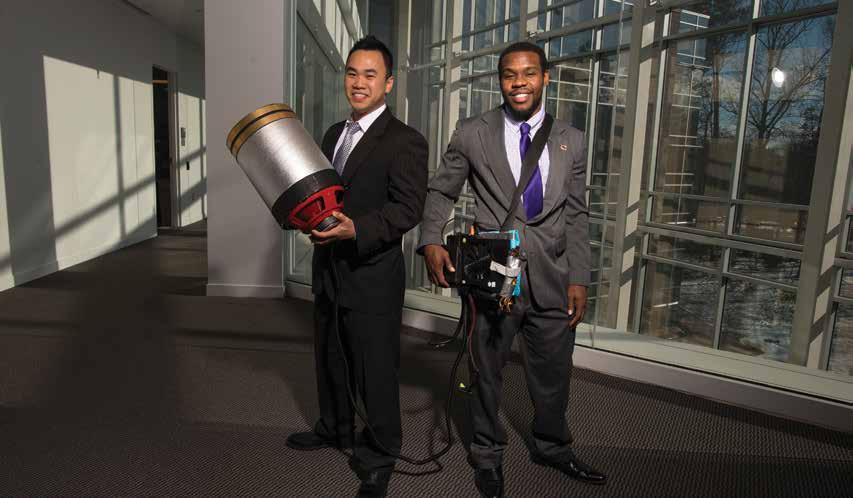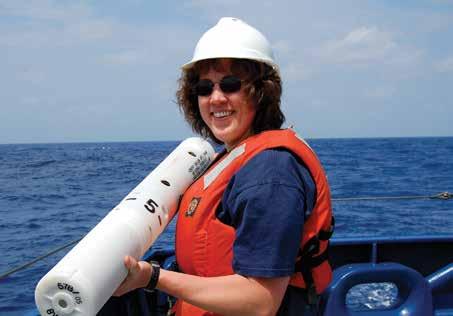
6 minute read
Signals and Communications
Designing and building devices and systems for applications in transportation, health care, and manufacturing
MArkerS And MileStoneS
2004 Electrical and Computer Engineering celebrates 20 years
2015 Electrical and Computer Engineering video about fghting fre with sound reaches more than 3.4 million viewers on YouTube
Pump Up the Bass to Douse a Blaze:
Mason Students’ Invention Fights Fires
A thumping bass may do more than light up a party— it could fat out extinguish it, thanks to a new sound-blasting fre extinguisher by George Mason University undergrads.
The fre extinguisher uses low-frequency sound waves to douse a blaze. Engineering seniors Viet Tran and Seth Robertson now hold a preliminary patent application for their potentially revolutionizing device.
The idea to fght fre with sound waves came when they were choosing a class project for ECE 492 and 493, Advanced Senior Design, where students produce and present a project for a fnal grade.
Tran and Robertson's 20-pound, Flash Gordon-style prototype was born through $600 of their own money and about as many trials. Their sound-wave device is free of toxic chemicals and eliminates collateral damage from sprinkler systems. If mounted on drones, it could improve safety for frefghters confronting large forest fres, urban blazes, and even fames in space.
"Fire is a huge issue in space," Tran says. "In space, extinguisher contents spread all over. But you can direct sound waves without gravity," adds Robertson.
Initially, both students thought big speakers and high frequencies would douse a fre.
"But it's low-frequency sounds—like the thump-thump bass in hip-hop that works," says Tran, who joked that rappers like 50 Cent could probably douse a fre, and that hip-hop celebrity endorsements might be just the ticket to hawk their fre extinguisher.
It has taken time for their idea to catch on. In researching ideas for the class project, Tran learned that the Defense Advanced Research Projects Agency (DARPA) was working on the concept, and that West Georgia University was working on "Prometheus." So Tran thought, "Why don't we be the ones to make it happen?"
Robertson and Tran's classmates said, "You guys will make us fail." Several professors also threw cold water on their idea before they convinced Electrical and
Computer Engineering professor Brian Mark to mentor their project.
"My initial impression was that it wouldn't work," he says. "Some students take the safe path, but Viet and Seth took the higher-risk option."
Mark knew nothing about fre extinguishers, so he took a wee step into the abyss himself.
"They're really special," Mark says of the duo. "Viet is the idea man, and Seth is practical. At the fnal presentation, he wanted to use some fancy new presentation technology, but Seth convinced Tran to stick with a simple PowerPoint. They didn't win the competition, but their presentation before a large audience was impressive."
The inventors make a powerful team. They met as freshmen. Tran, an admitted sub-stellar student in high school, and a pitiful culinary pupil who couldn't tell a zucchini from a cucumber, learned study discipline from Robertson, a student-athlete who mastered time management. "I'd wake up at six after we studied until three in the morning, and he'd already be at wrestling practice," Tran says.
Robertson works for the Department of Defense while studying, and he's been ofered a permanent position at Hanscom Air Force Base in Bedford, Massachusetts. Tran has an internship at Zodiac Aerospace in Dulles, Virginia, with the promise of a full-time job upon graduation.
Mason helped the inventors apply for a provisional patent.
"The provisional patent application they fled gives them a year to talk publicly about the invention, to test the market, and to determine whether pursuing the patent makes sense," says Carolyn Klenner, intellectual property paralegal in Mason's Ofce of Technology Transfer, who assisted them with the patent application.
Keep your eye on these young inventors.
A version of this story by Molly Brauer appeared in Mason News.
Students Viet Tran (left) and Seth Robertson with their invention, a sound-wave fre extinguisher, at the Fairfax Campus.

Listening to the Ocean
Kathleen Wage’s love of the ocean led her to study its sounds. An associate professor in the Department of Electrical and Computer Engineering, Wage studies sounds in the ocean and enjoys spending time on research ships. Not surprisingly, the U.S. Navy is interested in this type of work, and her Ocean Acoustic Signal Processing group has received nearly $1 million in funding from the Ofce of Naval Research for two separate grants.
From the time she was an undergraduate at the University of Tennessee–Knoxville, to when she interned at Oak Ridge National Laboratory, through her graduate work at Woods Hole Oceanographic Institution, to her recent project in the Philippine Sea, Wage has been interested in signal processing and how sound travels underwater.
“Underwater there is no such thing as GPS, and sound is the only efective way to determine the position of submerged objects,” says Wage. “Sound travels diferently in the ocean than it does in the air. It travels much farther and at a very low frequency. It doesn’t travel in a straight line, and it is afected much more by ambient or background noise.”

Volgenau researcher Kathleen Wage prepares to deploy a sonobuoy from the research vessel Melville during a 2009 Philippine Sea experiment. Wage has been at Mason since 1999 teaching and researching problems that blend array processing, acoustics, and oceanography. Her current research combines her knowledge of signal processing and her love of the ocean.
Wage’s research group is collaborating with Lora Van Ufelen of the University of Hawaii who is an oceanographer. In this study, they aim to characterize ambient noise in the deep ocean, understand how sounds scatter due to internal waves, and develop new processing techniques that make acoustic tomography easier to use by employing stationary and mobile platforms.
From 2009 to 2011, Wage spent 55 days onboard research ships, deploying arrays of hydrophones (underwater microphones) and other equipment. Now her group is focusing on analyzing data from a 5-km long vertical line array from this voyage. The research is relevant for a number of applications, including tracking seasonal variability of the ocean environment, detecting submarines, and conducting seismic surveys.
Earlier, the team was awarded a grant for work on co-prime sensor array processing. The ONR Basic Research Challenge program funds this project, which will investigate techniques for designing sonar arrays that require fewer sensors, making them more cost-effective and energy-efcient.
Wage hasn’t been at sea since the PhilSea experiments in 2011, and says she misses the ocean environment. “My time now is spent with my team here at Mason, running programs and analyzing the data,” says Wage. “The emphasis on real data, as opposed to simulated data, is a theme that runs throughout our research. As important as simulations are, things often look diferent on paper than they do in the physical world.”
Her next ocean voyage to gather more data may take her to the Arctic to measure the noise of the polar ice caps. “We know more about the surface of the moon than we do about the earth’s oceans,” she says.










